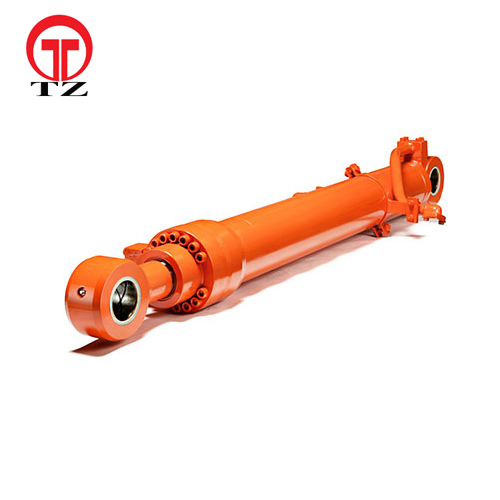ระบบไฮดรอลิกให้การกระตุ้นที่มีประสิทธิภาพสำหรับเครื่องจักรและยานพาหนะอุตสาหกรรมทุกชนิด. หัวใจสำคัญของระบบเหล่านี้คือกระบอกไฮดรอลิก, ซึ่งแปลงแรงดันของเหลวเป็นการเคลื่อนที่หรือแรงตามเส้นตรงหรือแรง. กระบอกสูบไฮดรอลิกสองตัว โดยเฉพาะอย่างยิ่งมีบทบาทสำคัญเนื่องจากขนาดกะทัดรัด แต่ความสามารถในการเคลื่อนไหวแบบสองทิศทาง. โพสต์บล็อกนี้จะสำรวจด้านวิศวกรรมที่สำคัญของกระบอกสูบพิเศษเหล่านี้.
กระบอกไฮดรอลิกที่ทำหน้าที่สองครั้งคืออะไร?
กระบอกสูบสองตัวที่มีพอร์ตสองพอร์ตที่อนุญาตให้ของเหลวไฮดรอลิกสลับแรงดันทั้งสองข้างของลูกสูบ, การเปิดใช้งานส่วนขยายและการเพิกถอนในตัวถังเดียว. การดำเนินการแบบสองทิศทางนี้ช่วยให้ส่วนประกอบสามารถเคลื่อนที่ได้ในสองทิศทาง, แตกต่างจากกระบอกสูบที่ทำหน้าที่เดี่ยวซึ่งผลักหรือดึงจังหวะต่อขยาย. กระบอกสูบที่ทำหน้าที่สองครั้งให้รอบการเคลื่อนไหว 180 องศามากกว่าจังหวะ 90 องศาจากสองซิงเกิ้ล.

แอปพลิเคชันทั่วไป
กระบอกสูบสองตัวเล็ก ๆ ด้านล่าง 5 เส้นผ่าศูนย์กลางนิ้วมักจะพบบทบาทในแอปพลิเคชันเช่น:
ลิฟท์กรรไกรและยกตารางสำหรับการปรับความสูง
อวัยวะเพศหญิงและการกระตุ้นสปอยเลอร์ในยานพาหนะ
มือปืนอุตสาหกรรม, หนีบและบีบ
อุปกรณ์ก่อสร้างอุปกรณ์ก่อสร้าง
อุปกรณ์การแพทย์ที่เปล่งออกมา
ข้อต่อและตำแหน่งของหุ่นยนต์
ลักษณะที่กะทัดรัดของพวกเขาช่วยให้การติดตั้งในพื้นที่แคบ ๆ ในขณะที่สร้างแรงจำนวนมากจากโรคหลอดเลือดสมอง.
การออกแบบและการดำเนินงาน
หัวใจของกระบอกสูบเป็นลูกสูบเหล็กแข็งที่ขับเคลื่อนด้วยของเหลวไฮดรอลิกแรงดัน. ความคลาดเคลื่อนที่แม่นยำและพื้นผิวขัดเงาช่วยให้การรั่วไหลน้อยที่สุดในอดีตซีล. หลอดกระบอกถูกสร้างขึ้นจากเหล็กชุบแข็งหรือโลหะผสมอลูมิเนียมเพื่อความทนทาน. พอร์ตที่ตั้งอยู่ที่ปลายคันและก้านจะช่วยให้แรงดันอิสระที่ด้านใดด้านหนึ่งของลูกสูบผ่านสายการผลิต. ท่อภายในเส้นทางของเหลว, ด้วยวาล์วถ่วงดุลที่ควบคุมทิศทางการไหล.
ในระหว่างการขยาย, แรงดันของเหลวจากปั๊มผ่านหนึ่งพอร์ตเพื่อเลื่อนก้าน. การเพิกถอนเกิดขึ้นเมื่อของเหลวออกจากพอร์ตนี้และเข้าสู่พอร์ตตรงข้ามด้านหลังลูกสูบ. การติดตั้งแบบก้านจะสิ้นสุดและการป้องกันการกำหนดค่าแพ็คเกจที่สมบูรณ์. ส่วนประกอบภายในรวมถึงซีล, ตลับลูกปืนและแมวน้ำเพื่อลดแรงเสียดทานในระหว่างการขี่จักรยาน.
ลักษณะประสิทธิภาพ
ข้อกำหนดที่สำคัญของกระบอกสูบที่ทำหน้าที่สองครั้งรวมถึงความยาวจังหวะ, เส้นผ่านศูนย์กลางของรูเจาะกำหนดแรงส่งออก, และแรงดันใช้งานสูงสุดถึง 5000 พีเอสไอ. อายุการใช้งานที่ยาวนานขึ้นขึ้นอยู่กับปัจจัยต่างๆ เช่น จำนวนรอบการทำงาน, การออกแบบรถเข็นคัน, ซีลที่ใช้และความสะอาดของน้ำมันไฮดรอลิก. ความเร็วของการสั่งงานจะแตกต่างกันไปมากขึ้นอยู่กับอัตราการไหลของปั๊มที่ตรงกับขนาดกระบอกสูบ. แรงที่ผลิตได้มีตั้งแต่เพียงไม่กี่ปอนด์ไปจนถึงหลายตันสำหรับขนาดรูที่ใหญ่ขึ้น.
การพิจารณาขนาด
เพื่อเลือกขนาดกระบอกสูบให้เหมาะสม, การคำนวณแรงหรือแรงกดดันที่จำเป็นในการเอาชนะเป็นสิ่งสำคัญ. ความต้องการระยะชักบวกกับช่องว่างที่จำกัดขนาดกระบอกสูบขั้นต่ำ. ต้องให้ความสนใจกับสลักยึดและปลายก้านด้วย, การเชื่อมต่อของไหล, และขายึดหรืออะแดปเตอร์ที่จำเป็น. บางครั้งการทดสอบจำเป็นต้องมีการจำลองเพื่อยืนยันประสิทธิภาพที่เพียงพอโดยไม่ต้องมีขนาดใหญ่เกินไป. ผู้ผลิตให้การสนับสนุนด้านวิศวกรรมการใช้งานและการเลือกแค็ตตาล็อกสำหรับการใช้งานทั่วไป.
การบำรุงรักษาและความน่าเชื่อถือ
กระบอกไฮดรอลิกแบบดับเบิ้ลแอคชั่นต้องการการบำรุงรักษาเพียงเล็กน้อยเนื่องจากมีการออกแบบที่เรียบง่าย, แต่ปัจจัยบางประการมีอิทธิพลต่อความน่าเชื่อถือในระยะยาว. การควบคุมการปนเปื้อนผ่านการกรองคุณภาพสูงช่วยยืดอายุซีลและตลับลูกปืน. การระบายอากาศเชิงกลยุทธ์ช่วยลดความกังวลเรื่องการเกิดโพรงอากาศ. การติดตั้งที่เหมาะสมพร้อมระบบป้องกันการหมุนจะช่วยป้องกันความล้มเหลวจากความเมื่อยล้าก่อนวัยอันควร. ผลกระทบจากการขยายตัวเนื่องจากความร้อนควรได้รับการแก้ไขในการออกแบบกระบอกสูบด้วย. การตรวจสอบเป็นระยะช่วยให้สามารถเปลี่ยนซีลและโอริงได้ก่อนที่จะเกิดความล้มเหลว. โดยรวม, การผลิตที่มีคุณภาพพร้อมพิกัดความเผื่อที่แน่นหนาเมื่อจับคู่กับน้ำมันไฮดรอลิกที่สะอาดทำให้มีอายุการใช้งานที่เชื่อถือได้นานหลายปี.
สรุปแล้ว, กระบอกไฮดรอลิกแบบสองทางขนาดเล็กมีความสามารถในการสั่งงานแบบสองทิศทางในพื้นที่จำกัด. ฟังก์ชันการทำงานที่หลากหลายช่วยให้กระบวนการทางอุตสาหกรรมและการเคลื่อนย้ายอุปกรณ์ทุกประเภทผ่านการออกแบบระบบไฮดรอลิกอัจฉริยะ. การบัญชีอย่างถูกต้องสำหรับเกณฑ์การคัดเลือกทำให้มั่นใจถึงประสิทธิภาพสูงสุดและความน่าเชื่อถือในระยะยาว.
